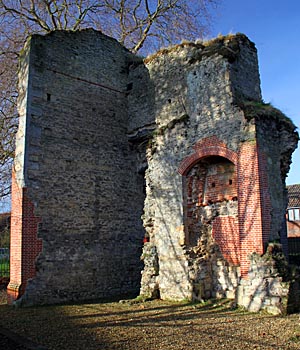 |
 |
|||
|
|
Barton is the north-eastern suburb of Abingdon. Before all the houses were built, the area around Barton Court Farm was extensively excavated and revealed a large Roman villa estate. The main house was originally a simple rectangular building but, over the centuries, it gained the usual terraced corridor and also a wine cellar. A smaller building stood opposite and there were grain dryers nearby. The whole was surrounded by an elaborate maze of banks and ditches. When the Romans left our shores, the villa was apparently left in a state of advanced decay. Very early Saxon settlers quickly moved in, however, and built their little sunken floor huts amongst the ruins. By the time of the Norman conquest the area had grown into a small village worthy of note in the Domesday Survey (1086), where its name appears to apply to the whole area around Abingdon. Shippon, north-west of the town, was Sipene at Domesday: this is the Serpen Hill on which a battle supposedly took place between the Saxons & the Danes in the 9th century. This was presumably when the Viking host marched north from Reading in AD 871 and burnt Abingdon and its abbey to the ground. At least some of the local militia seem therefore to have put up some resistance. The 16th century travel writer, John Leland even saw parts of their trenches remaining. The FitzHarris estate is only just north of central Abingdon. King William gave the area to a Norman knight called Owen, just after the Conquest. The motte of his castle can still be seen off Kingston Close. The name comes from Hugh FitzHarry who lived there in the 13th century. He wasn't a popular man locally since he imposed huge fines on people when their livestock strayed onto his property. He eventually sold up to Abingdon Abbey. However, at the last moment, he was somewhat reluctant to leave and the monks had to call in a professional negotiator. FitzHarris House was later built immediately south-west of the old motte and became the residence of the Tesdale and Bostock families. The Tesdales were related to the founder of Pembroke College, Oxford. After the Second World War, it became a girl's school but this did not last and the mansion was demolished in 1953.
Barton Court was the home of the great Reade family. They were keen Royalists and, during the Civil War, King Charles I was entertained at their home on a number of occasions by Sir Thomas Reade. It was from here that the King said goodbye to Queen Henrietta Maria for the last time, before her journey to Exeter and France in April 1644. After Abingdon fell to the Roundheads, Sir Thomas’ grandson, Compton, had to lead the defence of their house until it "was burnt over his head", probably in March 1646. Barton was was left in ruins and the Reades did not return. Timbers from the house featuring Parliamentary bullet holes were reused in the nearby Barton Court Farm and the Bowyer family later built a replacement mansion that was pulled down in the 1970s.
|
|||
| © Nash Ford Publishing 2004. All Rights Reserved. This location is now administered by Oxfordshire County Council. | ||||




 Though owned by
Though owned by